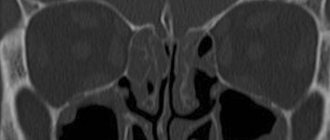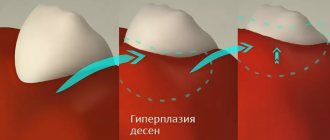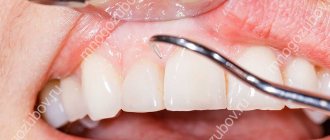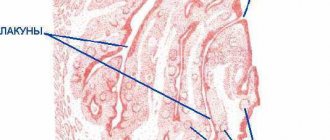In ENT practice, there are cases when a patient comes to an otolaryngologist with complaints of severe nasal congestion and suppuration from the nasal cavity. At the same time, the patient has an elevated body temperature and headaches. But the ENT doctor, having examined the patient, sends him to see a dentist. “Why?”, you will be surprised. Because in this case we are dealing with odontogenic sinusitis.
Sinusitis is a type of sinusitis. The development of sinusitis of odontogenic nature is not associated with colds or acute respiratory viral infections. The main cause of the disease is bad teeth. First, the development of inflammatory tooth disease occurs, after which the inflammatory process from the upper jaw extends beyond the oral cavity and is localized in the maxillary sinus.
Such a state cannot be tolerated. Timely detection of symptoms and diagnosis carried out by a competent ENT doctor will allow timely diagnosis of dental sinusitis and avoid serious complications.
What are the maxillary sinuses
The maxillary sinuses (also called the maxillary sinuses) are special cavities on both sides of the nose that are filled with air. Each cavity is connected to the nasal passage by small openings called anastomoses. The cavities are covered with mucous membrane. The function of mucus is to trap bacteria and harmful particles in it, and then remove them from the body through those same anastomoses. When edema occurs, the excretory opening becomes very narrow, as a result of which mucus, along with harmful particles and bacteria, cannot come out and stagnates. At this time, the patient begins to experience bursting pain in the cheek area - this is how inflammation of the maxillary sinus begins. Treatment of the maxillary sinus should not be neglected, since inaction can provoke serious consequences, including sepsis and meningitis.
Classic sinusitis can be bilateral, when both sinuses are affected. In the odontogenic form, the inflammatory process starts in the sinus on which side the diseased tooth is located.
What are dentists crying about?
This is the time for dentists to cry - if 2 years ago the treatment and filling of dental canals by our colleagues from another clinic had been carried out in accordance with modern standards, today and for many years to come our patient would not have had problems with either teeth or sinusitis.
Treatment of tooth canals (endodontic treatment) 20 years ago abroad became a separate scientific direction and a separate clinical specialty. The reason was frequent complications after endodontic treatment. The unique anatomy of the canals in different people and the need for hardware control at each stage (it is impossible to see the structure of the canals of the tooth in the patient’s oral cavity with the naked eye!) make it possible to compare canal treatment in terms of complexity with microsurgery. And the quality of root canal treatment is extremely important not only for the long-term functioning of the teeth, but also for the health of the entire body (the sad confirmation is the case of patient N.)
It is to prevent possible complications that year after year scientists around the world invent new technologies, methods and drugs for high-quality, reliable endodontic treatment.
Naturally, complex technologies require significant financial support, and not every medical institution is ready to invest in the purchase of expensive equipment and medicines, or annual training of staff in new techniques. That is why there is treatment “the old fashioned way”; not only technologically, but also morally outdated methods and drugs are used.
Types of odontogenic inflammation
The disease begins with a serous form. It is characterized by swelling of the mucous membrane, nasal congestion, dilation of capillaries, and increased secretion production. Swelling of the tissues leads to a narrowing of the anastomosis, the mucous masses do not find a way out and mucus with pathogenic contents accumulates in the sinus. This is how serous inflammation turns into purulent inflammation.
There are also acute and chronic forms of the disease. Chronic odontogenic sinusitis occurs due to improper treatment of acute sinusitis. Chronic odontogenic sinusitis lasts for years, worsening during a decrease in immunity or when infected.
Odontogenic sinusitis is diagnosed by an otorhinolaryngologist, and treatment is carried out by two specialists: a dentist and an otorhinolaryngologist.
Types of acute sinusitis
There are catarrhal and purulent forms of sinusitis.
Make an appointment right now!
Call us by phone or use the feedback form
Sign up
The name “catarrhal” comes from the medical term “catarrh,” meaning “to flow, drain.” That is, with this form of sinusitis, inflammation of the mucous membrane and its swelling develop quite quickly. Initially, the changes affect only the mucous membrane. Inflammation during sinusitis of this form is accompanied by severe swelling of the mucous membrane - it noticeably increases in size and, as a result, a little later transparent mucus forms. Only thanks to timely treatment, it is possible to prevent the transition of catarrhal forms into purulent sinusitis, which with a high degree of probability can become chronic.
With purulent sinusitis, direct contact of pus with the mucous membrane degenerates it, quite quickly and, what is most dangerous, irrevocably. Thus, with improper treatment or no treatment at all, you can very easily and simply join the army of people suffering from a chronic form of sinusitis.
The cause of the purulent form of sinusitis (acute sinusitis) is bacteria. The secreted mucus contains streptococci, staphylococci, and less commonly pneumococci and fungi, which leads to the appearance of purulent contents in the sinus itself.
Causes of odontogenic sinusitis
It is very easy to understand why acute odontogenic sinusitis occurs - just look at the anatomy. If you look at the structure of the skull, you can see: the 5th, 6th and 7th teeth of the upper jaw are located very close to the maxillary sinus. There are cases that these teeth even go into her cavity. An infection in a tooth easily thins the already small distance between the tooth and the wall of the sinus and easily penetrates inside, thus starting the inflammatory process.
Development in acute form occurs due to the following reasons:
- Improper oral hygiene.
The most common cause of the disease is neglect of basic rules of oral care: improper and irregular brushing of teeth, delaying a visit to the dentist when there are problems with the teeth. At particular risk are those patients who have been diagnosed with an advanced form of caries with developing necrosis of the dental nerve. - After tooth extraction.
Infection after tooth extraction is associated with the formation of a fistula - a small channel through which the infection enters the maxillary sinus. This occurs when the roots of a diseased tooth enter the maxillary cavity. - Incorrectly installed seal.
Unfortunately, there are cases when the development of inflammation is facilitated by the inept actions of insufficiently qualified dentists. Part of the filling can get into the sinus, and it will immediately be perceived by the body as a foreign particle, and the inflammatory process will start. If after visiting the dentist you have a runny nose, you need to consult an otolaryngologist. - Oral diseases.
Caries, gum disease, periodontal disease, the presence of cysts are all diseases in which there is a source of infection on the oral mucosa. - Reduced immunity.
Decreased immunity leads to the activity of bacteria that are constantly in the oral cavity.
Reasons for the development of sinusitis
Acute sinusitis can be caused by the following factors:
- colds;
- viral infections: ARVI, measles, influenza, etc.;
- allergic reactions;
- damage and injury to the nose;
- untreated teeth, tooth roots entering the cavity of the maxillary sinus, inflammation of the gums.
In medicine, it is customary to distinguish two ways of infection entering the maxillary sinuses: when the infection penetrates from the nasal mucosa into the maxillary sinus or when the infection develops directly in the maxillary sinus through blood flow and general inflammation.
Sinusitis (in addition to bacteria) can be provoked by factors that interfere with normal air circulation and the release of mucous masses from the sinuses. These include:
- deviated nasal septum;
- adenoids;
- cyst;
- polypous formations;
- and etc.
Unfavorable environmental conditions - dust, gas pollution, work in hazardous industries - can also disrupt the process of the release of mucous masses from the sinuses and further treatment.
Symptoms of the disease
The symptoms of the disease are similar to classic inflammation of the maxillary sinuses. Only a highly qualified otolaryngologist will be able to distinguish odontogenic sinusitis from ordinary sinusitis.
Signs of odontogenic sinusitis are:
- constant nasal congestion;
- purulent nasal discharge with a characteristic odor;
- the appearance of odor from the patient’s mouth;
- pain in the cheek area under the eyes;
- acute toothache in the upper jaw;
- elevated body temperature.
Symptoms also include a general deterioration in well-being, a persistent feeling of fatigue, and problems sleeping.
Specific symptoms of purulent odontogenic sinusitis are pain when lightly pressing on one of the cheeks or when lightly tapping on the teeth located in the area of the inflamed sinus.
Chronic odontogenic sinusitis is manifested by discomfort in the affected sinus area. In general, the patient feels satisfactory until a period of exacerbation occurs.
Treatment of sinusitis
Depending on the patient’s condition and the course of the disease, the doctor prescribes therapy and selects antibacterial, decongestant and anti-inflammatory drugs. Treatment can be conservative or surgical.
Conservative treatment
For mild sinusitis, in addition to drug treatment, according to indications, nasal cavity lavage according to Proetz, or “cuckoo”, is performed. A special solution is injected into the nose of the patient lying on his back. It passes through the nasal cavity, sinuses, after which it is pumped out with a vacuum pump. “Cuckoo” is carried out in a course of 2 to 10 procedures.
For moderate and severe cases of the disease, antibiotics are prescribed in the form of tablets, solution for injection or inhalation.
Surgical treatment (puncture of the maxillary sinus)
In case of severe purulent sinusitis or lack of effect from conservative therapy, a puncture is used. This allows you to quickly remove pus from the sinus, clean it and treat it with an anti-inflammatory drug. Sometimes several similar manipulations are required. Punctures are performed under local anesthesia.
When sinusitis cannot be treated or is in an advanced stage, surgery is performed under general anesthesia. The period of complete recovery after surgery can take up to two weeks.
What can hurt with sinusitis?
According to the medical reference book of symptoms and syndromes: “Sinusitis is characterized by severe pain, in which the head, teeth, eyes and bones may ache. Depending on the localization of this unpleasant feeling, it differs in pathogenetic mechanism (mechanism of development and manifestation), etiological factors (in origin).” Also, depending on the location of the organ that hurts, it is possible to differentiate sinusitis from other types of sinusitis (since there are nine paranasal sinuses of the upper respiratory tract, lined with mucous membrane, there are a corresponding number of nosological units).
Most often, patients complain that their teeth hurt. There are two possible mechanisms – bottom-up and top-down. The first is considered if the teeth are the primary focus of the lesion, that is, the inflammatory or infectious process began in these organs. Further, it can spread to the maxillary sinuses (both on the right and left sides), since they have a direct connection with the cavity of the oropharynx.
The relationship between sinusitis and toothache
If we talk about a descending lesion, then the primary focus may not be the teeth, but the mucous membrane of the air pocket. This situation is described by clinicians much more often and is more predictable due to the typicality of the pathological process (catarrhal drainage of exudate and its accumulation in cavities that are anatomically located below - a feature characteristic not only of sinusitis).
For differentiation, the time period of symptom manifestation is used. If the tooth initially hurts, this speaks in favor of an ascending inflammatory process. Just like if your teeth hurt after characteristic rhinorrhea and nasal congestion, you can conclude that sinusitis is descending.
The following combination of symptoms is often encountered: “I constantly have a stuffy nose and pain in the bags under my eyes.” This, although indirectly, is also a sign of sinusitis, since under the eyes there is a “canine fossa” (anatomical formation, which is represented by a depression in the maxillary bone), into which the maxillary sinus is projected. Additional diagnostic evidence of the correct diagnosis can be increased intraocular pressure, since the edematous mucous membrane puts pressure on the excretory ducts of the chambers of the eye. In this case, in addition to compressive pain, there is redness of the visible sclera and pronounced swelling of the lower eyelids. A complaint such as “there are tears in my eyes” is considered pathognomic.
The maxillary sinuses are located in close proximity to the brain and are connected to the cavity of the cranium by a complex system of passages, therefore sinusitis may also be characterized by pain, which is classified as a headache. The mechanism of its appearance is similar to why the eyes hurt - it’s all due to pressure, although this time it’s intracranial. In connection with a new pathophysiological element, complaints such as “I have a feeling of fullness in my ears” or “I always feel as if I have dived under water” may be encountered. This description is quite common in the scientific works of practicing clinicians.
Surgery
It is not always possible to get rid of inflammation in the paranasal sinuses by washing, using antibiotics, or warming procedures. In case of purulent sinusitis, surgical intervention is used:
- in the absence of a positive result for 5 days;
- at high temperature;
- severe headache;
- with swelling of the connecting canal.
The procedure is carried out after anesthesia. The wall of the sinus is pierced with a thick needle. An antiseptic is injected with a syringe and the pus is removed.
After a sinus puncture, the person’s condition improves and the pain goes away. Treatment is continued with physiotherapeutic procedures and rinsing the nasal cavity with antiseptics.










